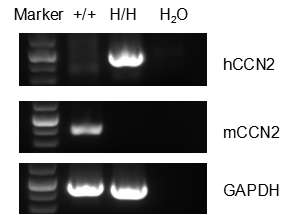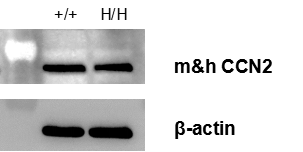B-hCCN2 mice
| Strain Name |
C57BL/6N-Ccn2tm2(CCN2)Bcgen/Bcgen
|
Common Name | B-hCCN2 mice |
| Background | C57BL/6N | Catalog number | 111523 |
| Related Genes | CCN2,cellular communication network factor 2,CTGF, HCS24, IGFBP8, NOV2 | ||
mRNA expression analysis

Strain specific analysis of CCN2 gene expression in wild-type mice and B-hCCN2 mice by RT-PCR. Mouse Ccn2 mRNA was detectable in kidney of wild-type mice (+/+). Human CCN2 mRNA was detectable only in homozygous B-hCCN1 mice but not in wild-type mice.

Strain specific CCN2 expression analysis in homozygous B-hCCN2 mice by Western blot. Kidney tissue was collected from wild-type C57BL/6 mice (+/+) and homozygous B-hCCN2 mice (H/H), and analyzed by western blot with anti-CCN2 antibody. CCN2 was detectable in wild type mice and homozygous B-hCCN2 mice, as the antibody is crossly reactive with CCN2 in human and mice.
In vivo efficacy of anti-human CCN2 antibody with bleomycin-induced B-hCCN2 mice

Anti-human CCN2 antibody inhibits collagen deposition in lungs of bleomycin-treated B-hCCN2 mice. B-hCCN2 mice were assigned to one saline non-bleomycin control group (n=4) and two bleomycin-treated fibrosis groups (n=9) which were treated with pamrevlumab (in house, anti-human CCN2) or vehicle. Pamrevlumab treatment was able to improve bleomycin-induced weight loss in B-hCCN2 mice(A). Fibrosis in this model was scored by the standard measure of total lung HYP. In control mice, bleomycin treatment increases HYP content compared with controls. Compared with vehicle-treated bleomycin controls, pamrevlumab treatment resulted in a reduction in mean induced lung HYP content (B). Values are expressed as mean ± SEM. *** p<0.001, **p<0.01.











 京公網安備: 11011502005564號
京公網安備: 11011502005564號